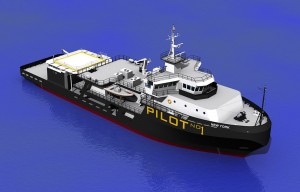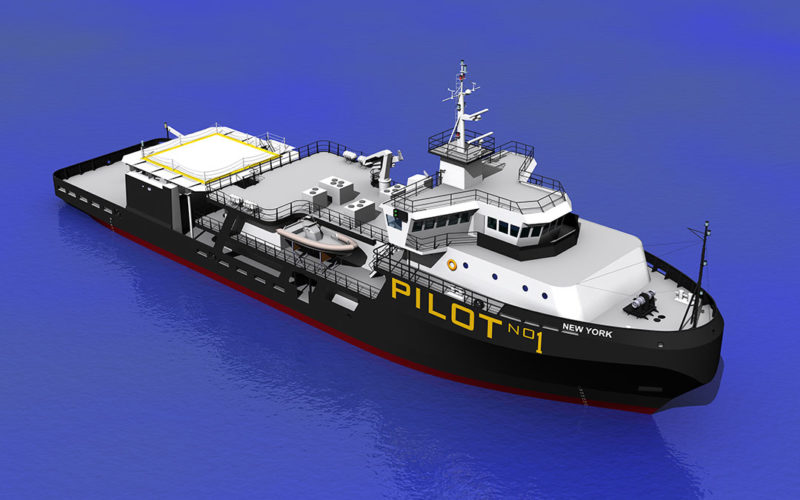
The Sandy Hook Pilots Association is in the final months of an unusual conversion project, transforming a deactivated 28-year-old oil spill response vessel (OSRV) to replace the pilot boat New York, the largest and oldest vessel operated by the group.
For close to a decade, the association had been considering possibilities for replacing New York, an Ambrose-class station boat that is nearly a half-century old. Then, when Capt. John DeCruz was in Portland, Maine, for an American Pilots’ Association meeting in 2018, he heard about Maine Responder, an OSRV that had been in layup at the Union Wharf since 2016.
“Although Maine Responder was well maintained and in excellent condition, the decline in tanker activity in Portland led the vessel owner, Marine Spill Response Corp. (MSRC), to deactivate the vessel,” said Blake Powell, president of JMS Naval Architects, the Mystic, Conn.-based company that provided design guidance for the conversion. “The timing was fortuitous for the Sandy Hook pilots.”
“The main engines had less than 10,000 running hours on them,” said DeCruz, New York president of the Sandy Hook Pilots Association. “Despite the age of the vessel, it had very low hours and was extremely well maintained by MSRC. It was the most cost-efficient route to take compared to if we’d built a station boat from scratch.”
The vessel, which is being converted by Feeney Shipyard of Kingston, N.Y., has been re-registered as a second pilot boat New York and is scheduled for delivery in late summer. The current pilot boat New York is the largest station boat in the nation at 182 feet, soon to be surpassed by its 208-foot replacement.
After the Sandy Hook pilots bought Maine Responder from MSRC, they hired Ron Shaw, project manager at Old Salt Marine Consulting Services in Northampton, Pa., to oversee the conversion in conjunction with Ed Burns, port engineer for the pilots. An initial dry-docking was conducted at Caddell Dry Dock and Repair in Staten Island, N.Y. The American Bureau of Shipping and U.S. Coast Guard surveyed the vessel and its oil recovery equipment was removed.
The existing crew quarters and helicopter pad are being retained. A new two-level deckhouse section will be connected to the existing house. The new section has been built for pilot berthing and includes a lounge and crew mess. The vessel’s bridge wing extensions will have floor-to-ceiling windows facing aft and downward, and side windows that slide open.
Technology upgrades include closed-circuit television cameras, two-way speakers and a buzzer system for communication between the pilothouse and mess and the port and starboard boarding areas. Also, because New York will hold station for up to six weeks before needing to come ashore for fuel and fresh water, tank capacity has been increased from 20,000 gallons of potable water to 60,000 gallons.
Other modifications include the addition of a port rescue station with net recovery system, deck de-icing systems in the boarding areas, a hot water/steam system to de-ice pilot boats when they come alongside in winter, and a new knuckle-boom crane to load gear and handle rigid inflatable boats.
“The heavy steel work is complete and the crew is working on finishing coatings, plumbing and carpentry,” said Tim Feeney, co-owner of Feeney Shipyard, in early April. An average of 20 people a day — including fitters, welders, electricians, plumbers and carpenters — have been working on the project since early September.
“Integrating new systems with original systems is always a challenge, but fortunately there was very good documentation,” Powell said. “Other modifications had to be made to incorporate operational capabilities specific to the pilots’ mission, specifically boarding the vessel at sea safely.”
The Sandy Hook Pilots Association has had a station boat since the group was founded in 1694, back when New York was still a British colony. New York and a second station boat, New Jersey, combine to provide pilot coverage 24 hours a day, 365 days a year and in all weather conditions, serving vessels entering or departing the Port of New York and New Jersey, the Hudson River, the East River, Atlantic City, Jamaica Bay and Long Island Sound.
“Our job, as professionals with knowledge of the area, environment, weather conditions and the channels, is to safely bring ships into port,” DeCruz said. “But we’re not just pilots; we’re here to serve.”
In the days after 9/11, New York served as a command center to communicate with vessels evacuating people from Manhattan. In 2012, Sandy Hook pilots helped the Coast Guard and Army Corps of Engineers survey damage after Hurricane Sandy.

